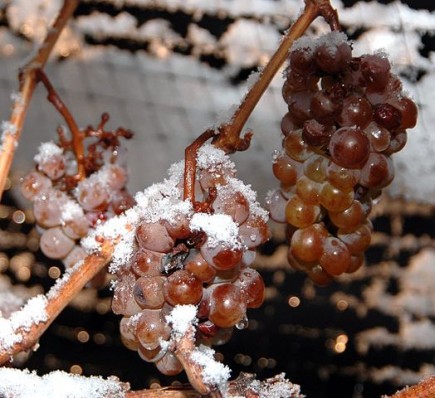
European wine and cheese are coming to dinner
by Will Mazgay, Digital Editor

For wineries, there are opportunities to be had in a massive EU market, but for cheese producers, unfettered access isn’t quite as appetizing

Icewine grapes in Ontario’s Niagara region. PHOTO: Dominic Rivard, via Wikimedia Commons
Free trade will eliminate all tariffs on wine for both Canada and the EU, and provide a new bi-lateral quota of 18,500 tonnes of tariff-free cheese for import into and export out of Canada.
The lifting of these restrictions presents both opportunities and headaches for Canadian wine and cheese.
For Michael Barrett, president and CEO of Gay Lea Foods, the prospect of exporting to Europe isn’t very enticing for his dairy cooperative.
“Gay Lea is not putting a lot of effort into accessing the supposed tariff-free European market. There’s a lot of barriers to entering the EU, first and foremost being the price of milk,” Barrett said.
The Dairy Farmers of Canada say climate and transportation costs contribute to the high price of producing and processing milk in Canada.
While exporting isn’t on its radar, Gay Lea is expecting to gain a larger import quota from the CETA provision and is prepared to take advantage.
“For us, we’d like to be able partner with cheese manufacturers in Europe that are innovating,” Barrett said.
Cheese giant Saputo isn’t convinced.
“We’ll wait until we have more information available to see how we adjust to these new changes,” said Sandy Vassiadis, Saputo’s vice president of Corporate Communications.
While the cheese industry approaches CETA with trepidation, some Canadian wine-makers are diving into European markets head first.
Peter Toms, director of sales and channel development for Diamond Estates Winery in Niagara, has been busy establishing a foothold in Europe, a market that includes 14 of the world’s top 15 wine drinking nations. After connecting with a distributor at a trade show last year, Toms is preparing to ship his products everywhere from Poland to Portugal.
“European expansion was in our plans already. Anything that happens with lower tariffs, the potential for freer trade, that’s an added bonus for us. We want to be there as those things come into play, so we’re already in the market and can take advantage of them,” Toms said.
There are opportunities for growth in Europe, but Canadian wine-makers need to tend to their own gardens as well.
Canadian wineries command just 30 per cent of the domestic market.
A European Invasion
The Canadian wine market has been under assault from Europe since 2004, when the Canada-European Community Wine and Spirits Agreement was signed. According to Dan Paszkowski, president and CEO of the Canadian Vintners Association, the trade agreement facilitated 71 per cent growth in the value of EU wine sales into Canada between 2004 and 2015.
With the elimination of tariffs that CETA brings, a lucrative Canadian wine market is becoming even more attractive to European exporters.
Diamond Estates is trying to stay proactive to maintain a competitive edge in Canada. New marketing strategies and expansion into the emerging grocery store market are initiatives aimed at growing domestically.
According to a November CBC story, European cheese will cut into roughly four per cent of the Canadian market under CETA.
The federal government is providing some assistance. A $250 million fund for dairy farmers and a $100 million fund for processors were promised by Agriculture Minister Lawrence MacAulay in November of last year, to improve technology and operations.
Paszkowski is looking for similar support for the wine industry.
“We’re seeking a grant whereby we put down the capital immediately to invest in our industry with say 30 per cent support on every dollar invested over a five year period, so that we can get immediate innovations in sustainable technology into place. That way we can compete with the tidal wave that’s coming from the European Union,” Paszkowski said.
That tidal wave will hit Canadian shores soon, and when it does, our wine and cheese producers will need to be prepared.